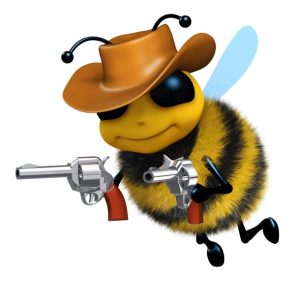What is your stance on stance?
A prominent local CCW instructor saw me using my favorite default shooting stance — Modified Weaver — and told me “no one” uses it anymore. He runs large classes and apparently teaches only Isosceles, the stance which, unquestionably, is the one currently in vogue.
I cannot be sure of his reasons for limiting training to Isosceles, but my hunch is that demise of Front Sight (where I trained for over twenty years) together with the rapid spread of permitted concealed carry along with mandatory training requirements (instructors typically with law enforcement ties) has led to the spread of training with a law enforcement bias. That bias is mostly a good thing, but can be bad where it is not optimized for the private armed citizen. Large classes filled with students who often take only the minimum required training may also have something to do with popularity of the relatively simple-to-learn Isosceles stance. While Isosceles is a favorite of some top competitors (who often transition to Weaver or something else for successive targets), that does not mean it is best for everyone on the street.
I noticed something else peculiar in that class: if the class is representative of trends, there seems to be a movement against the concept of shooting a “controlled pair”, which has long been recommended due to the poor stopping power of handgun rounds. A “controlled pair” requires both speed (for fight-stopping impact) and a second sight picture (because unsighted double-tap is irresponsible). [A third sight picture is recommended for good follow through.] Yet the class seemed to disapprove of controlled pairs in what appears to me to be a “cop-out” (excuse the pun) based on their surrender to the inferior recoil control of their favored Isosceles stance. If you remove controlled pairs, you remove much of the need for recoil control and hence also remove the need for upper body strength or leaning forward, etc. Unfortunately, you also remove stopping power, which is essential for self-defense. There was something mentioned about controlled pairs not being acceptable because the situation may change, and no doubt quite a bit could change if you are not controlling recoil enough to allow a rapid second shot. (While practicing extreme isometric tension, I was able to get my follow-up shot time down to .22 second — not a lot can change in one-fifth of a second.) In my analysis of the three major stances below, I will assume all three methods employ the recoil control necessary to allow use of controlled pairs for fight-stopping hits.
The free training I offer here focuses on Modified Weaver not only because it is my personal favorite and I am more familiar with it, but also because in my opinion it is the best stance for most people in most situations. However I also teach Isosceles and traditional Weaver, as I would never recommend learning only one stance. Differing circumstances may require differing stances for differing shooters. Best to learn and practice all three major stances, and variations among them. I would encourage training with multiple local instructors to develop your own best default style, perfect for you.
Also, no trainer is perfect, and training with multiple instructors minimizes the chance you will engrain bad habits. These bad habits may be mental as well as physical. For example, another local instructor, while assisting the more prominent one mentioned earlier, was at one point lecturing students on the gravity of the “decision to take a life” and in fact repeated this exact phrase many times. Can you imagine how these exact words would sound to a police officer or jury? The phrase “decision to take a life” indicates a purposeful act, with the specific intent to take a life. To justify self-defense you must intend only to stop the attack. Lethal force is fine if necessary under Aquinas’ theory of double effect, but you can never intend to take a life.
So getting all of your training in one place can lead to disaster for you and your family.
Diversity in firearm training, on the other hand, allows you to easily transition between all three stances depending on your condition, and the situation you find yourself in, as you stop an attack.
In briefly describing some of the pros and cons of each stance here, words will have to suffice for this article. A more thorough article would require many pictures or diagrams because of various interpretations of the three stances.
ISOSCELES
As the name implies, the key aspect of the Isosceles stance is the isosceles triangle (two sides same length) formed by two arms extended, elbows locked, straight out from the shoulders, with chest square to target. [So-called variation “Modern Isosceles” may bend the elbows a bit (no longer a triangle), but to the same degree so that head is still erect.] Recoil control (for faster controlled pair, i.e., second shot) is achieved with extreme, aggressive lean forward and upper body strength. Though often taught with both feet square to firing line, requiring extreme lean forward with curving of the spine, this is impractical for fighting and more stability can be achieved with extreme, aggressive lean forward on feet bladed similar to the boxer’s stance used with the other shooting stances. Yes, this so-called “Modified Isosceles” unfortunately requires pivoting the hips.
Advantages
Advantages of Isosceles include:
- simple to teach (but more training is always better)
- instinctive fighting position (but more training can improve on instinct)
- squaring torso to target maximizes effectiveness of body armor (if you like to wear body armor — definitely the favorite stance of law enforcement)
- easiest to adapt for cross-dominant eyesight (head and gun centered on target, so only slight movement of head required)
- maximizes range of movement toward firing side (critical where unable to move feet due to mud, snow, stairs, wheelchair, car seat, glue factory, briar patch, etc.)
- easily adapts to multiple foot positions (helpful when dealing with multiple or moving targets, doesn’t matter which foot forward)
As my comments indicate above, the first four of these advantages are not significant for most serious students and practitioners of concealed carry. However, the last two are very important reasons for everyone to know Isosceles! Have it in your toolkit as an alternate stance, if not primary.
Disadvantages
Disadvantages of Isosceles include:
- locking elbows may be painful for those with injured or arthritic elbows
- not good for those (e.g., paraplegics) who cannot get shoulders and upper body weight forward, for recoil control
- Isosceles does not work well for revolvers [added per this suggestion by respected colleague at Safe Shooting School up in the Bay Area: “Something to add (because most consider it outdated) is that Iso stance/grip is incompatible with revolver shooting. I’ve found that not only are the thumbs far enough forward to be exposed to the cylinder gap, but it doesn’t interface as well with the grip frame/shape (as compared to a semiauto). I teach a modified Weaver with thumbs high (keeps them out of the way and can manually cock the hammer without disturbing the firing grip) to revolver shooters. -Daniel R”]
- lacks the isometric tension found in other stances, so to control recoil Isosceles requires more extreme lean forward than other stances, which reduces stability, and may also require great upper body strength
- although bladed stance can improve stability of forward lean and recoil control, with Isosceles bladed stance requires hips to pivot toward target, and this pivot may be bad for knees or at least feel awkward (pivot of hips is not required for other stances)
- assuming bladed stance, limited range of movement toward support side (where unable to move feet due to mud, snow, stairs, wheelchair, car seat, glue factory, briar patch, etc.)
- while good for moving targets, NOT good for shooting “on the move” because increased radius of extended arms aggravates bounce, with no shock-absorbing isometric tension to absorb the bounce
The first three disadvantages listed above apply only to some people, but everyone should consider the last four when choosing a stance for the particular situation.
WEAVER
Key aspect of Weaver (named after a deputy sheriff in California) is isometric tension (about like wringing a wet washcloth, unless your hands shake when you wring a wet washcloth) between the firing arm (pushing forward) and the support arm (pulling backward). Support elbow is pointed straight down, resulting in a downward vector for recoil control when the support arm is pulled backward. Firing elbow is also pointed down to some degree, but the firing arm is a bit straighter than the support arm, depending on position of feet and angle of fire. With both elbows bent, head is necessarily canted to the firing side, even more if the shooter’s eyesight is cross-dominant (dominant eye on different side than dominant hand). Forward lean is actually optional with Weaver, but leaning a bit may add some beneficial recoil control.
Advantages
Advantages of Weaver include:
- no locking of elbows is better for those with injured or arthritic elbows
- forward lean helpful but not required; shock-absorbing isometric tension reduces need for aggressive lean forward (important for some in wheelchairs, or otherwise disabled)
- works well with restrictive clothing that prevents full extension of arms
- faster draw with elbows bent than extending arms fully
- faster tracking of moving target or multiple targets due to shorter radius (gun closer to body due to bent elbows)
- maximizes range of movement toward support side (critical where unable to move feet due to mud, snow, stairs, wheelchair, car seat, glue factory, briar patch, etc.)
- works well for shooting while moving, because of smaller radius with bent elbows, and also because of the shock-absorbing isometric tension reducing “gun bounce”
While the first three advantages may not be important for most people, the other four are important considerations for most people in choosing a stance.
Disadvantages
Disadvantages of Weaver include:
- bladed torso exposes an area of vulnerability around armpit and upper side, for those wearing body armor
- may increase need for better hearing protection, depending how tight (degree of bend in firing arm)
- most difficult stance for those with cross-dominant eyesight to adapt
- even for those with normal eye dominance, vision is not optimal because head is not erect
- those with weaker arms may get “limp wrist” malfunctions
For most people, the last two on the list are the most significant. Field of vision is very important in a gunfight, and malfunctions can be deadly.
MODIFIED WEAVER (or CHAPMAN)
Key aspect of Chapman (named after the competitor who came up with it, and did very well) is that the firing arm is extended straight out, with firing elbow locked. With elbow locked there can be no isometric “push” so technically it is dynamic tension of the support arm pulling firing arm into its shoulder socket. Downward vector for added recoil control is still provided by that support elbow pointing downward, as with Weaver. Chapman is often called Modified Weaver, despite lacking true isometric tension, which is key in Weaver.
True Modified Weaver is technically distinct but very close to Chapman, and involves a slight bend to the firing elbow so it is not locked, just enough bend to allow isometric tension. This is my preferred method. That slight bend allows some shock absorption from isometric tension to moderate the fulcrum effect of an extended arm and therefore lessen the need for aggressive lean forward, versus what it would be with elbow locked, while preserving most of the benefits of Chapman. Remember, better recoil control means faster follow-up shot (faster controlled pair). Focusing on extreme isometric tension, I’ve gotten my follow-up shot time down as low as .22 second — one fifth of a second! For me, Modified Weaver is a good balance between Chapman and Weaver and the best default stance for me to use generally, allowing easy transition to Weaver and Isosceles where needed.
Both Chapman and Modified Weaver allow head to be erect, as with Isosceles.
Both methods require bladed stance, with firing foot back as in a boxer’s fighting stance. Degree of blade varies, usually about 30 to 45 degrees. With deeper blade, there is less mass (shoulder) behind gun for recoil control.
Both methods require some forward lean (about sixty percent of weight on forward leg, and shoulder an inch forward of the hip), for added recoil control, because whether elbow is locked or not, the firing arm is straight enough to act as a fulcrum if not counterbalanced.
Advantages
Advantages of Chapman / Modified Weaver include:
- consistency with long gun training due to straight (or nearly straight) firing arm
- more easily adaptable than Weaver for those with cross-dominant eyesight
- those with weaker arms less likely to get “limp wrist” malfunctions with Chapman or even with Modified Weaver, versus Weaver, because firing arm is straighter and absorbing more recoil
- regardless of eye dominance, head remains erect for maximal field of vision
- easy transition to Weaver or Isosceles where increased range of movement is required to either side (critical where unable to move feet due to mud, snow, stairs, wheelchair, car seat, glue factory, briar patch, etc.)
The most important advantages above, for most people, will be the last two on the list.
Disadvantages
Disadvantages of Chapman / Modified Weaver include:
- because firing elbow is locked, or firing arm is nearly straight, forward lean is required
- while body armor coverage is slightly better than Weaver, it is still inferior to Isosceles (for those who wear body armor)
- locked firing elbow may be painful for those with injured or arthritic elbows
None of these disadvantages will be material, for most people.
Again, for myself I have chosen Modified Weaver to be my default stance. I like the idea of preserving isometric tension to absorb recoil, while keeping my head erect. But if movement of my feet is restricted or I am facing a moving target or multiple targets or a “run and gun” situation, I can easily transition to Weaver or Isosceles depending which direction I need to turn to fire.
What is the best stance?







